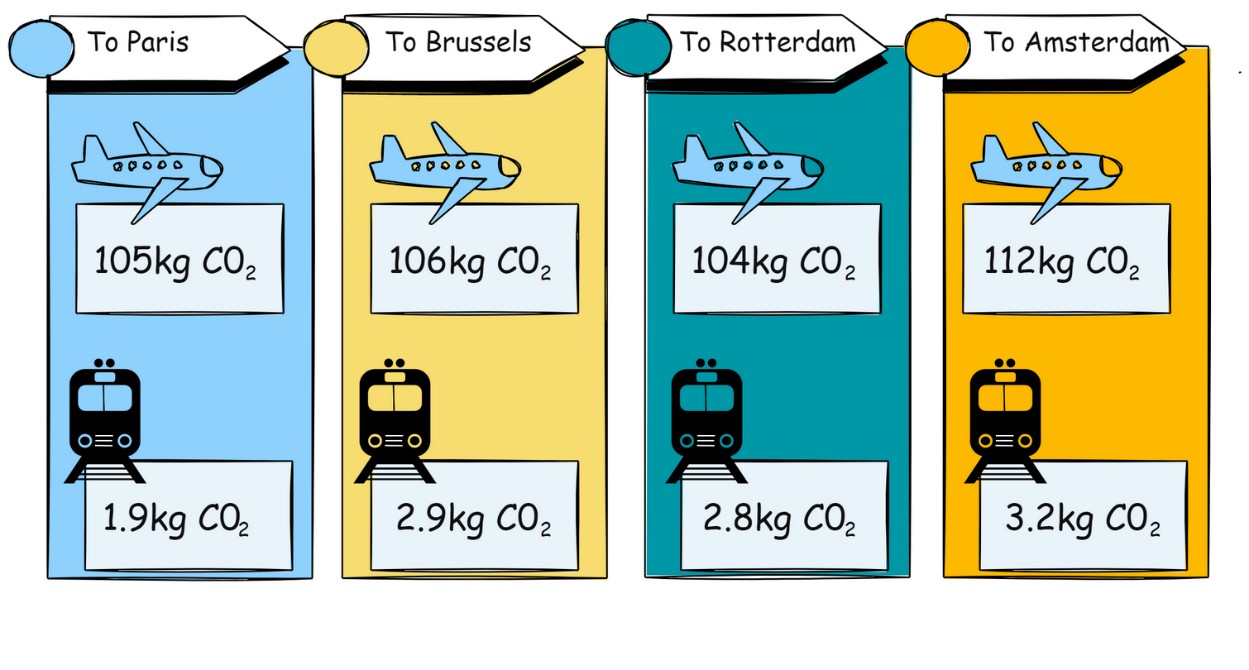How can I make a difference?
From an emissions perspective, rail is one of the best alternatives – the CO2 grams per passenger kilometre being emitted are significantly lower than those produced by air travel (about 86% less emissions for national travel and around 97% less when travelling with internationally).
Because of the huge carbon savings that can be made here we are asking you to strongly consider using high speed rail options and sleeper trains for both domestic and European travel. The infographic below gives some examples of the carbon savings which could be made by travelling via international rail (based on UK Government Greenhouse gas reporting conversion factors, 2022):
Flying vs International Rail (one way)
 Based on the figure above a round trip from London to Paris could save the atmosphere from over 206 kg of carbon (that’s about the weight of a sea-lion)[1].
Based on the figure above a round trip from London to Paris could save the atmosphere from over 206 kg of carbon (that’s about the weight of a sea-lion)[1].
It’s important that you book through Clarity Travel so that we can accurately track emissions – however if you are considering making a European trip via rail there are several useful sites which can help you with your planning:
Case Study: Professor Andy Jones from the Faculty of Health and Life Sciences
Professor Jones made the decision to make the return trip from Wigan to Montpellier via rail rather than flying, saving approximately 328 kg CO2[2] in the process - that’s about the same weight as a grizzly bear. We asked him a few questions about his experience:
Andy, what was the rationale for your decision?
My rationale was entirely based on trying to save CO2. In our family life, we barely fly, since we know the importance of climate change, so it seems wrong then if I fly around the world for work. I am asked to attend/present at meetings almost every month, and I want to fly as little as possible, which means I have to disappoint a lot of people who expect me to come their events. I felt there was an opportunity to get to Montpellier for a workshop via rail, so I decided to give it a go.
How long did your journey take?
It took about 13 hours door-to-door.
What resources did you use to research your trip?
I asked for advice on Twitter, and researched a bit on the web, including the Man in seat 61.
What was the approximate cost differential?
I didn’t cost up flights, but the rail option was pretty expensive (around £400). Fortunately, we had a lot of unspent funds on research grants, so we were not limited by this factor, but I expect this could be an issue for some people.
What was your journey like?
The experience overall was mixed. Several trains ran late, with one missed connection and two connections made with only minutes to spare (somewhat stressful)! I also didn’t realise that Eurostar terminals are like airports and need 90 minutes to get through security and passport control in a worst case. At that time though, airports were also reported to be hugely chaotic so I doubt that air travel would have been any better.
I think the University should strongly encourage all staff to consider and discuss how they can take steps to reduce their carbon footprint.
Did you learn anything useful which you’d like to pass on?
I missed a connection in France due to late running Eurostar and the French rail network gave me a new ticket (and an upgraded seat) at no extra cost. In the UK though, it is more complicated. If you have a regular Advance single ticket (say from Euston back to the NW), you may not be able to take a later train. There is a different type of ticket you need to book called a CIV which can be booked through Clarity travel.
Any final thoughts?
Overall, I would encourage people to give it a try, and just treat the travel as a workday, so time is not “wasted”. Usually trains have power sockets and with 4 or 5G, so it is possible to do most things as in an office.
[1] Source: www.weightofstuff.com
[2] estimates of one way travel were made: 1180km flight distance, 283 kms of UK national railway and 928 kms international railways, based on www.airmilescalculator.com and www.thetrainline.com respectively. Calculations made using UK Government Greenhouse gas reporting: conversion factors 2022.